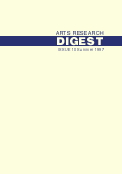
CATEGORY:
EDUCATION
TITLE OF RESEARCH
The Effects and Effectiveness of Arts Education in Schools: Interim report 1
COMMISSIONED BY
NFER, The RSA, The Arts Council of England, ABSA, Calouste Gulbenkian Foundation, Comino Foundation
Authors
John Harland, Kay Kinder, Jo Haynes, Ian Schagen
(October 1998) Slough: NFER, 120 pages, ISBN 0-7005-1498-8, £6.00
ARTS RESEARCH DIGEST
The Effects and Effectiveness of Arts Education in Schools: Interim report 1
OBJECTIVES
To document and evidence the range of effects and outcomes attributable to school-based arts education; to examine the relationship between these effects and the key factors and processes associated with arts provision in schools; to illuminate good practice in schools' provision of high-quality educational experiences in the arts; and to study the extent to which high levels of institutional involvement in the arts correlate with the qualities known to be associated with successful school improvement and school effectiveness.
METHODOLOGY
Phase one of the three-year project includes: case studies of five secondary schools which have a reputation for good practice in the provision of arts education; analysis of existing `Quantitative Analysis for Self-Evaluation' data collected by NFER; piloting a Year 11 pupil survey.
CONTENTS
The study; Teachers' perceptions of the effects of arts education; How the perceived effects varied between artforms; Pupils' perceptions of the effects of arts education; Studying arts-based subjects and GCSE performance; Summary and conclusions; References; Appendix 1.
SUMMARY
The report identifies the perceived effects of school-based arts education by teachers. Personal development outcomes attracted more nominations than all the direct artform knowledge and technical skills effects put together. The second most frequently cited, specific category referred to the perceived capacity of the arts to facilitate improvements in other areas of the curriculum through the transference of skills and knowledge acquired in the arts. It also collected accounts of the effects and effectiveness of arts provision from pupils. Across their responses as a whole, it was possible to see each of the 12 major types of outcome identified by the teacher sample. Overall, the scope and nature of teachers' claimed effects received substantial corroboration from their pupils, apart from two notable exceptions, which were rarely mentioned by pupils: thinking skills and transfer effects to other areas of the curriculum.
AVAILABLE FROM
NFER, The Mere, Upton Park, Slough, Berkshire SL1 2DQ, UK Tel: 44 (0)1753 574123 Fax: 44 (0)1753 691632